 France (1928-45), Oceanic Submersibles, 31 completed.
France (1928-45), Oceanic Submersibles, 31 completed.WW2 French Submersibles:
Surcouf | Requin class | Saphir class | 600/630 Tonnes class | Redoutable class | Aurore class | Roland Morillot class | Emeraude class | Phénix classFrance’s largest submarine class
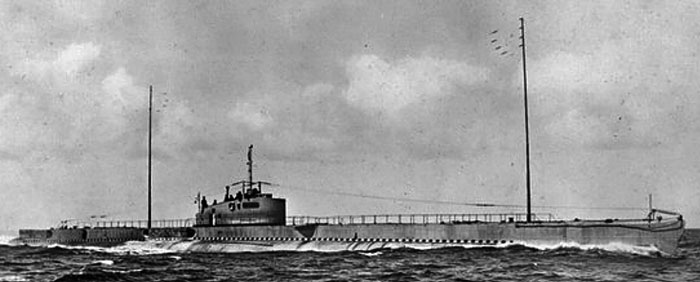
The “Redoutable class” -official name was 1500 tonnes- was initiated in 1925. The Washington Naval Treaty of 1922, signed by France indeed, tried to prevent a future naval arms race by limiting fleets and warship types. Like Italy, France was fairly limited in numbers of ships and resources to allocate for the defense of its colonial Empire. Some thus argued that having cruisers at all these stations was near-impossible and a cheaper alternative was to expand its submarine forces as a deterrent, not limited by the treaty after tumultuous discussions with Britain which at firdst wanted to ban them. Thus, after this concession was agreed upon, France started to consider these as an essential tool to defend its empire. From this early rearmament plan, four types emerged.
-The large sub-cruiser, as commerce raider (one built, surcouf)
-The long range oceanic submersible (Prototypes 1100 tonnes class in 1924, and later 1500 tonnes)
-The coastal submersible (600-630 tonnes, mostly confined to the mediterranean)
-The minelayer submersible (for wartime minefield operations close to enemy shores and harbours), Saphir class built.
Thus, France was to have in the following decade a coherent construction program in complete contrast with its pre-1914 “navy of prototypes”.
As for the oceanic category, France started with a first serie called the “1100-ton” also known in literrature as the “Requin-class” (shark) designed in 1922, right after the treaty. In fatc it was the very first poswtar French submersible class. This initial attempt to meet the new requirements however failed due to unsufficient speed while the overall design seemed still inferior to the 1918 UB-III and UC-III classes of 1918, of which some examples were obtained as war reparation.
The design for the successor of the 1100 tonnes class was commissioned from general engineer of maritime engineering Léon Roquebert. His task was to create a “grand cruiser” capable of not only defending an area by patrolling, surveillance of enemy bases, but also a more offensive role, destroying its communications lines. The last mission was as “colonial protection” in distant station. Even in that last task, it was to screen for a surface squadron. This implied good range and far better speed altogether.
This program became the “Type I” project, officially 1500 tonnes, with the lead boat being named “Le Redoutable”. The final design was approved by the superior council of the navy on 1 July 1924. The construction programme initially comprised about 2 “pre-production” subs, later was expanded the following year with the Type II submarines, lead boat Pascal, with the remaining 32 submersibles built in that class. Together with the Surcouf these 1500 tonnes were soon heralded as the elite of the French submarine fleet and many documentaries depicted them in the interwar.
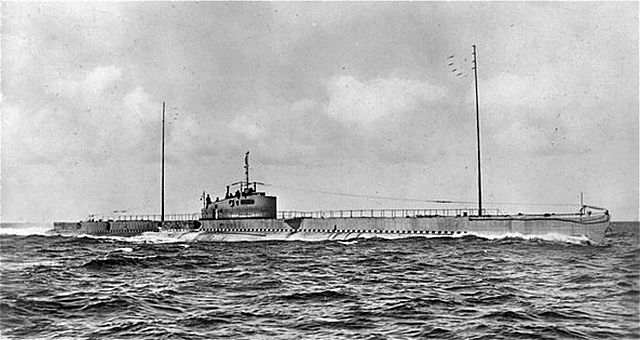
Le Prometehee off Cherbourg circa 1932. Its wireless transmitter masts are hoisted. This was during trials before sinking in 1932. The 100 mm deck gun had not yet been installed. – Src. L’Illustration n°4663, 20 juillet 1932. Plans
Note: There were two “Redoutable” class submarines in French service: The 1928 class of 32 oceanic models, and the 1967 class of six SSBNs.
Design of the class

The official call was “long patrol submarines”. It was also referred to as the class of 1500 tons. The series was important (thirty-one units) and lasted until 1937, in no less than three “subclasses”, those of L’Espoir and Agosta. The other two series, in 1928 and 1930, saw above all the improvement of their propulsive group. The first goal in designing this class, was to have a large radius of action, and speed came good second. Roquebert’s only solution to have more power was to add an entire section to the 1100 tonnes class, doubling the output while keeping the dispacement moderate. Thie “jumboisation” of the initial design is what gave the 1500 tonnes their elongated “stretched” caracteristic outlook. This helped reaching both objectives, but at a cost:
-Slower diving time
-Poor agility
Hull and general design
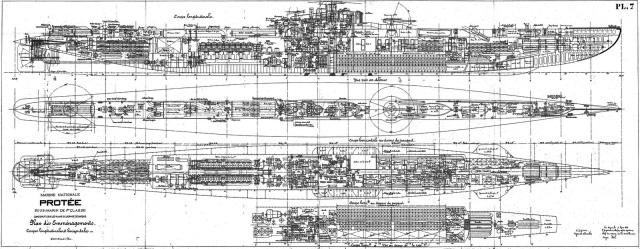
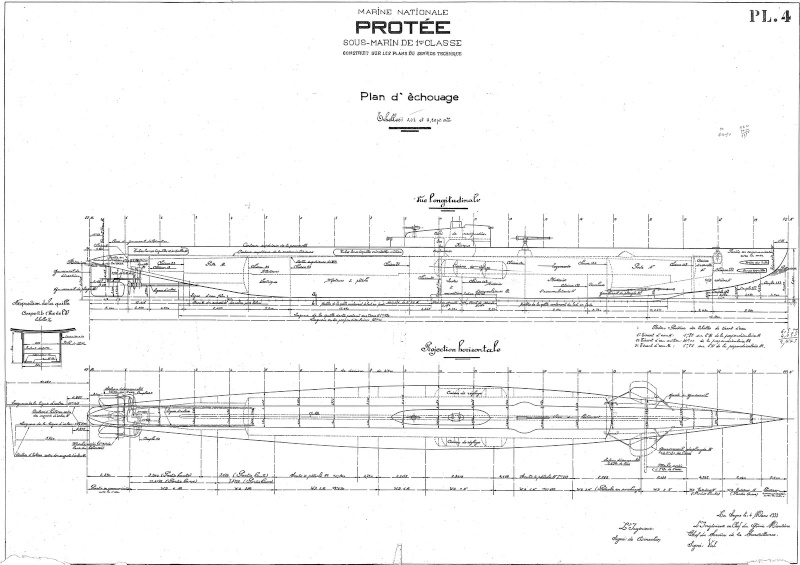
General Plan of Protée. Unfortunately only these low-def plan pages exist on the internet, and access to the Chatellerault archives is restricted to CNRS-affiliated historians
This stretching brought the overall lenght to 92.3 m (302 ft 10 in) long, but still with a moderate beam of 8.2 m (26 ft 11 in) and 4.9 m (16 ft 1 in) draught. To compare with the 1100 tonnes class, compared to 78.30 m (256 ft 11 in) by 6.84 m (22 ft 5 in) in beam (1/11 ratio) draught 5.10 m (16 ft 9 in). So they were larger, roomier, but kept this roughly 1/11 ratio, but had a lesser draught for shallow waters.
The double hull however was reinforced a bit compared to the 1100 tonnes, as to allow deeper dives as a measures of safety against surface attacks. However they were still rated for a “normal max” at 80 m (260 ft) depht, but in reality they could dive far deeper, like Archimède which recorded 120 m (390 ft) to test near-crash dive. This means they probably could even reach 130 m and more in the worst case scenario. This was better than the 600-630 tonnes but still paled in comparison of the 250m+ reached by the German Type VII in WW2. Surface displacement was 1,572 tonnes (1,547 long tons) hence the classifications, and submerged up to 2,082 tonnes (2,049 long tons). They proved able to dive in 40-50 seconds.
Construction:
The massive plan saw these boats built at:
Arsenal de Cherbourg Redoutable, Vengeur, L’Espoir, Le Glorieux, Agosta, Béveziers, Ouessant, Sidi Ferruch.
Arsenal de Brest: Pascal, Pasteur, Achille, Ajax, Le Centaure, Le Héros.
Chantiers navals français (Caen): Archimède, Persée.
Forges et chantiers de la Méditerranée (FCM, La Seyne, Toulon): Monge, Protée, Le Tonnant.
Chantiers de Penhoët (Saint-Nazaire) Fresnel.
Arsenal de Lorient: Henri Poincaré, Poncelet.
Chantier de la Loire (Nantes): Actéon, Achéron, Pégase, Le Conquérant, Sfax, Casabianca
Chantier Dubigeon (Nantes): Argo.
Powerplant

Compartimentation of the Pascal (Q138) – cc.
Propulsion while surfaced was provided by two 4,000 hp (3,000 kW) diesel motors for the two Redoutable and it was seen as too weak. The main production boats (Pascal variant) had 6,000 hp (4,500 kW) total, and from the sub-class Agosta, 8,000 hp (6,000 kW), with a top speed of 18.6 knots (34.4 km/h). 17 knots was the norm before. The diesels were provided by Swiss manufacturer Sulzer, with the exception of Pasteur, Poncelet, Archimède, Achille, Ajax, Argo, Prométhée, Persée and Le Centaure which had Schneider diesels. Their electrical propulsion, likely from Schneider-Harlé, allowed them to achieve 10 knots (19 km/h; 12 mph) underwater. Worthy of their denomination of «sous-marins de grande croisière» (great cruise submarines) surface range was ported to 10,000 nautical miles (19,000 km) at 10 knots (19 km/h) or even 14,000 nautical miles (26,000 km) at 7 knots (13 km/h). Submerged it was down to 100 nautical miles (190 km) at 5 knots (9.3 km/h). This was far better than for the 1100 tonnes class as expected. They carried 95 tonnes of fuel oil.

Plans of Pascal – Chatellerault archives via clausuchronia.org
Armament

The class kept basically the same arrangement as the 1100 tonnes type, but augmented:
-Four bow tubes, 550 mm (21-in) fixes with one reload each
-One rear twin bank 550 mm (21-in), traversing, no reload plus two 400 mm (16-in) reserved for merchant vessels
-One central triple bank 550 mm (21-in), traversing, no reload, aft of the CT.
So the peculiarity of the French design was that instead of stern tubes, the 1,500 tonnes had two surface orientable torpedo tubes banks, that can be only reloaded on the surface or in port, for eleven torpedo tubes total, four fixed forward, seven in traversing mounts on the surface, with one all-550 mm tubes and one aft mixing 550 and 400 mm tubes.
The central bank (aft of the conning tower) was smaller in size and the deck ran over it, not to disturb the crew’s movements.
The aft back was larger so as to house all four tubes of different sizes. Needless to say these could be launched while surfaced preferrably than underwater, and avoiding choppy waters.
French submarines torpedoes typical of the time were made at Toulon arsenal in southern France.
55 cm (21.65″) 24V and 24M Type, Modele 1924 (design) 1926 (service):
Weight: 3,285 lbs. (1,490 kg)
Overall Length: 27 ft. 2 in. (8.280 m)
Warhead: 683 lbs. (310 kg) TNT
Range/speed setting: 3,300 yards (3,000 m)/45 knots or 7,650 yards (7,000 m)/35 knots*
Engine: Schneider alcohol/air heater
*Later version 4,400 yds (4,000 m)/45 ks or 8,750 yds (8,000 m)/35 kts, 915 lbs. (415 kg) TNT warhead.
40 cm (15.75″) M26V (1926, service 1928)
Weight: 1,486 lbs. (674 kg)
Overall Length: 16 ft. 10.5 in. (5.140 m)
Warhead: 317 lbs. (144 kg) TNT
Range/Speed sttings 2,200 yards (2,000 m)/44 kts or 3,300 yards (3,000 m)/35 kts
Engine: Alcohol Wet-heater
This single-stage turbine engine torpedo was intended as merchant vessels for the submarine version, but it also existed in MTB version (26W) and seaplane-launched variant (26DA) which could be dropped from 260 feet (80 m). Overall a successful model. Src
Main Gun
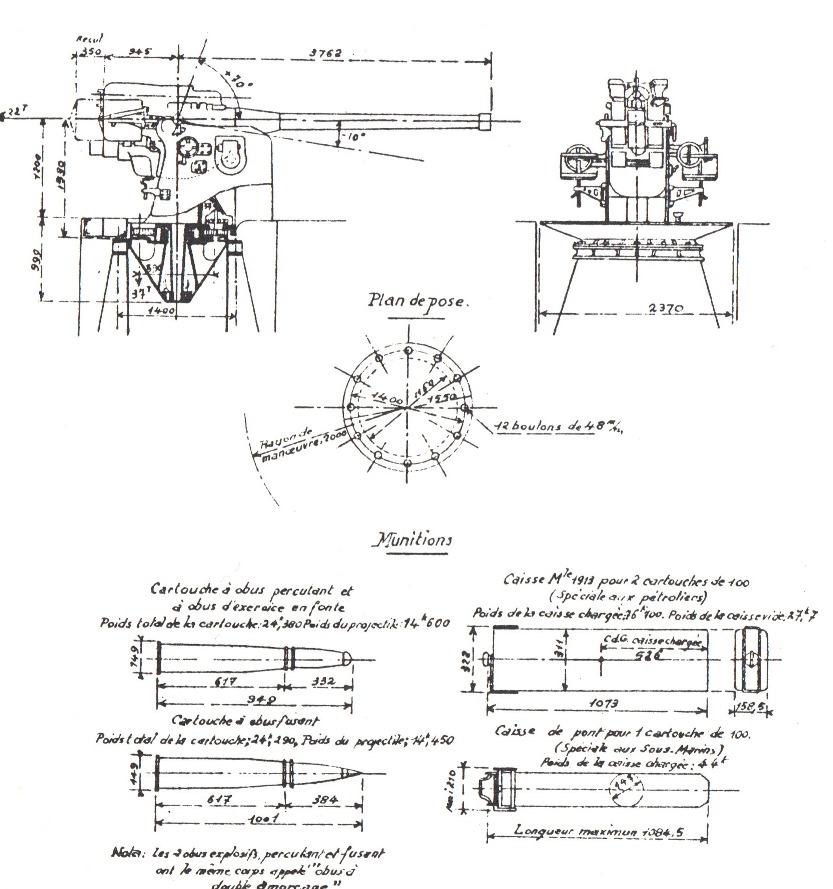
The canon de 100mm modèle 1925 was the main deck gun adopted for the Redoutable class, an improvement compared to the puny 75 mm on the 1100 tonnes class. Weighting 10 tonnes it could be fitted with an optional light steel shield and could elevate up to +70° on the SMCA mount at a rate of 8°/sec. and traverse 150° either side at 10°/sec. rate. Normally the 1500 tonnes carried 100 rounds.
This was tailored model for the Redoutable class submarines. It had a breech mechanism concentric ring construction.
It entered service in 1929, had a lenght of 185.3 in (4.707 m) and rate Of Fire of circa 10 rounds per minute.
It could fire a 53.6 lbs. (24.29 kg) HE rounds (full) 32 lbs. (14.45 kg) for the shell alone, 39.4 in (100.1 cm) long, with a 9.7 lbs. (4.4 kg) at a muzzle velocity of 2,493 fps (760 mps).
Ranage unknown. src
AA Guns
The 1500 tonnes had the same AA compared to the 1100 tonnes, with a twin 13.2 mm HMG on the aft conning tower platform. Sole sources states these were replaced in WW2 by a single 37 mm Hotchkiss gun.
Mines
It was projected to convert some of the boats as minelayers. In that case, they wouls have sported 32 mines in 16 well in two rows, likely aft and replacing the central triple TT bank. This never past the project stage.
All 1500 tonnes boats had a long range radio communication was through wireless antenna and two telescopic masts.

Author’s Illustration of the Casabianca
⚙ specifications |
|
| Displacement | 1390 t. standard – 2085t. Full Load |
| Dimensions | 92.5 m long, 8.20 m wide, 4.70 m draft ( x x feets) |
| Propulsion | 2 shafts Sulzer diesels, 2 electric engines 6000/2000 bhp |
| Speed | 17/10 knots, 19/10 kts* or 20/10 kts** |
| Range | 14,000 nm @7 knots surfaces 90 nm @7 knots submerged |
| Max depth | 80-120m+ () |
| Armament | 9x 550 mm TTs, 2x 400 mm, 1×100 mm deck gun, 1×37 mm, 2×13.2 mm AA |
| Crew | 61 (4 officers, 59 ratings) |
*Le Héros, Le Tonnant, Le Conquérant, L’Espoir, Le Glorieux
**Sfax, Casabianca, Agosta, Béveziers, Ouessant, Sidi-Ferruch
General Assessment of the 1,500 tonnes
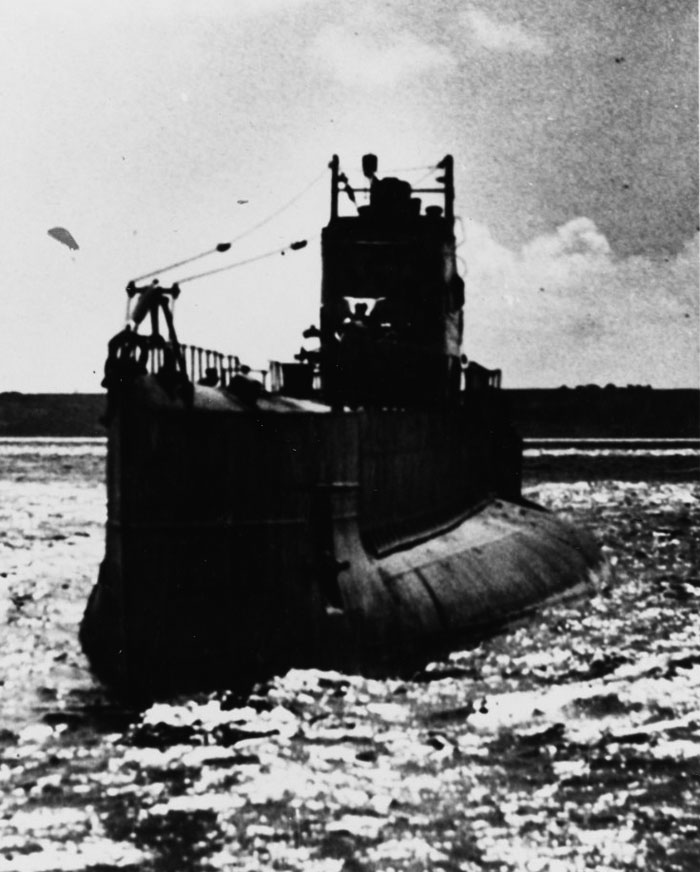
Agosta 27 July 1938 – naval historical command photo
A real improvement in French submarines design

President Doumergue wrenching the first rivet of Redoutable in 1925.
The official “long patrol submarines” term was alternated to “1,500 tons” in official documentation, not redoutable or the sub-class Pascal and Agosta. This was perhaps overall the greatest achievement of the interwar French Navy, having thirty-one boats with good armament and long range to count on as a “trump card” to be deployed in a large variety of missions. The design was considered good enough for production to lastuntil 1937 filling three “subclasses” with L’Espoir in addition to Agosta, both of the Type II. They were mostly concerned about improving their powerplant. How they compared to foreign competition ?
The only German submarines that come to mind were the Type IX. They had the same speed, but better oil bunkerage distribution for a greater range at 13,450 nmi (24,910 km; 15,480 mi) at 10 knots (19 km/h; 12 mph) surfaced.
Compared to Italian submarines, the contemporary Ballila class (1927) for example were a bit slower but carried more oil (140 tonnes) for greater range also. The 1940 Calvi class even carried 250 tonnes, so more than thrice what the 1500 tonnes can carry, hence their use to link Europe with Japan.
Diving time and depht was not stellar however, but their low draught enable them to patrol shallow waters, an interesting feature around some islands and remote overseas stations notably in the Pacific.
Issues
The large construction program was linked to a contract spread amongst private shipyards, some unused toi built submersibles, like at Caen or at the Loire. Construction orders concerned six annual tranches and small technical alterations were made in betwee, not always well communicated, which resulted from the experience from earlier batches. Delays in delivery however were caused in the program due to the aforementioned inexperience of some yards and bottleneck for parts coming from numerous suppliers. Sometimes more than two years were needed from laying down to completion, or more, and that spreading meant design disparities withing the class.
This had consequences in wartime for their maintenance. Construction of the lead boat, Redoutable, laid down on 1 July 1925, was probably the most acute. She was only launched on 24 February 1928, and commissioned by 10 July 1931, so seven long years, which given the technological advances at the time, made her near-obsolete already. The last laid down, Casabianca, entered service on 1 January 1937, and as she was based on essentially a 1922 design, she was indeed completely obsolete already. Ouessant and Sidi-Ferruch entered even service by January 1939 due to successive delays at Cherbourg. From 1936 indeed, general strikes in France delayed deliveries of parts and construction in general.
In 1940, they were seen as reliable, but vulnerable to attacks between htier slow diving speed, limited max depht, and shile submerged, their propulsion was found sensitive to shockwaves caused by depht-charges. In addition their underwater sound systems was basically inherited from WWI and completed obsolete by WW2 standards, they were also poorly armed to resist air attacks. Still they formed by tonnage 40% of the French submarine fleet.
Modifications were done however on the earlier batches in the late 1930s to alleviate their age, notably in navigation instrumentation. The only one significantly modified however was FFL Casabianca, modernized in the US by 1943 with a new conning tower, radar, and two 20mm AA Oerlikon guns. They were also consistently marred by their torpedoes, which performances were good in the 1920s, but no more in WW2. Fortunately for the allies (but also for the axis), they consistently failed to hit their targets, which were most often able to dodge the torpedoes, both easy to spot and relatively slow. This explained poor results, but also decisions by the allies to have them perform intel and transport missions, or just lack of targets in the Med by 1944-45.
A wasted potential
The Redoutable mostly performed escort jobs, surfaced, in the early stage of the war in 1939, were constrained by rigid operational convention against the axis ships, and had only a limited “window” of action against the Regia Marina in June 1940. The armistice consequences were crippling of course for the entire class, spread between many stations between Indochina, Syria, North Africa and Toulon. Thos of the Atlantic ports departed in emergency, but not for Britain. Instead they sailed to the Mediterranean and Dakar on the west coast, other going for the French west indies.
The irony was that from then on, they were all service for Vichy France. Famously on 25 September 1940 Vichy French Bévéziers torpedoed HMS Resolution off Dakar. This was enough to cancel the operation there after the combined British-FFL assault was repulsed. They mostly patrolled against allied ships and attacked them on some occasions. Most of those not destroyed by the allies in November 1942 and the remainder scuttled in Toulon with two exceptions. In the end only five joined the allies by late 1942. The most famous of these was Casabianca, only one with significant result. Four were rebuilt and modernized in the US and were active until 1945.
Succession: The Morillot or 1800 tonnes class
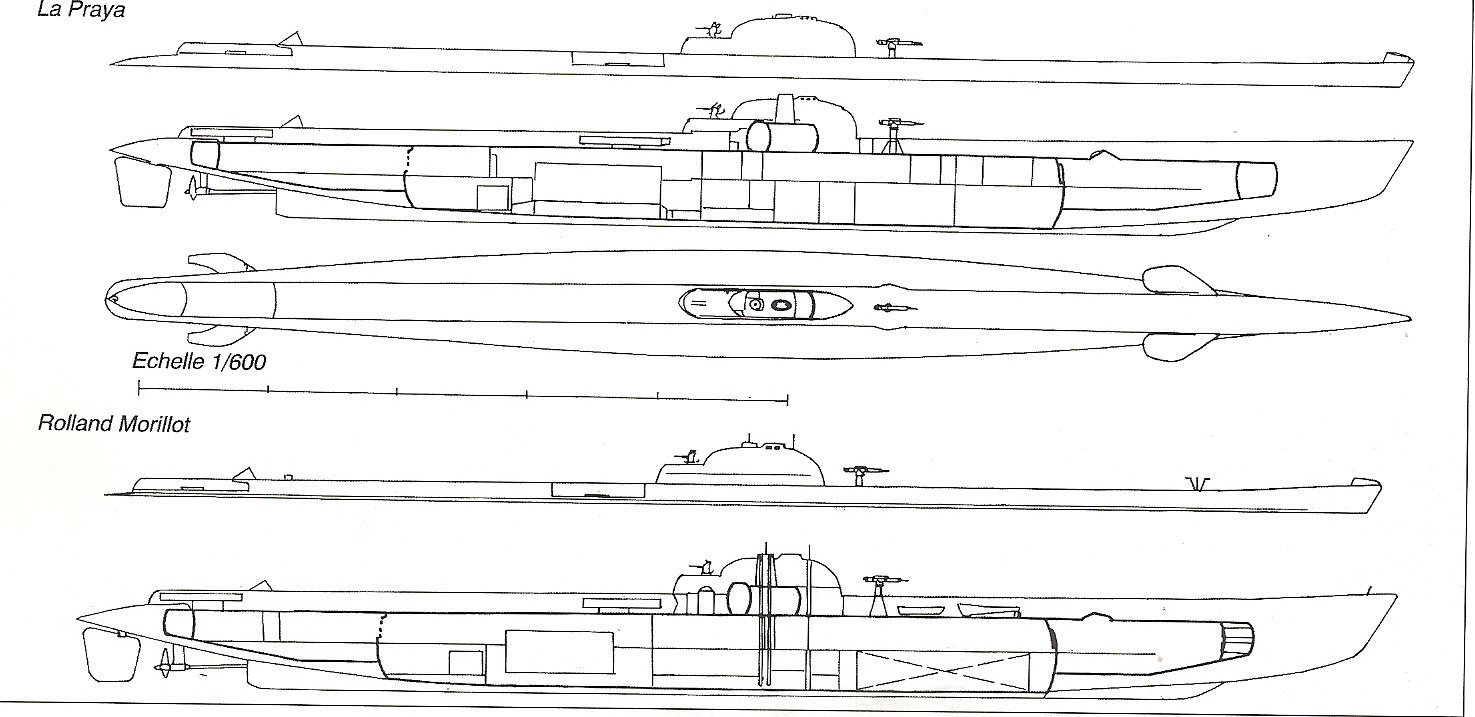
The Roland Morillot class was planned since 1933 as a replacement for the 1500 tonnes, taking in account all the lessons drawn from the shortcoming of these boats. They were designed by the engineer Pierre Paoli. The first critic was their lack of internal bunkerage for oil, which was increased by 85 tonnes (so 175 tonnes total), still not impressive, but enabling 10,000 nm at 10 kts. They had more advanced Sulzer diesels, enabling 22 knots in surface, which was excellent, and still 9 kts underwater thanks to a 12,000 shp/2300 shp arrangement, quite impressive for the time. This was on a 1817/2416 tonnes hull, 102.50 m long by 8.32 m wide and 4.50 in draught, so about the same elongated profile (336 ft x 27 ft x 14ft).
They had one more torpedo tube (12) but repeated the odd solutions of the 1500 tonnes in armament, having ten torpedo tubes, four in the bow, the rest in quad surface launchers, plus 19 400 mm torpedoes, the same 100 mm gun and still a twin 13,2 mm MG. They were all named after French islands. Started too late, none was completed:
-Roland Morillot was BU on slip in 1940 as La Praya and Martinique. Guadeloupe (Q-204) and Réunion (Q-205) were not laid down, and Q-228, 229 and 230 were cancelled. The name was given after the war to a war reparation Type XII which saw some extensive service in the French Navy from 1945 and helped creating the new generation of French conventional submarines, notably the Narval class. See also.
Read More
Books
Aboulker, Axel (2010). Marines Éditions (ed.). Le Sous-marin Archimède. Rennes.
Huan, Claude (2004). Les Sous-marins français 1918–1945. Rennes: Marines Éditions.
Picard, Claude (2006). Les Sous-marins de 1500 tonnes. Rennes: Marines Éditions.
Bagnasco, E (1977). Submarines of World War Two.
Gardiner, Robert (1980). Conway’s All the World’s Fighting Ships 1922–1946. Conway Publishing.
Le Masson, Henri (1969). The French Navy. Navies of the Second World War. Vol. 1. MacDonald & Co
L’Herminier, Jean (1949). Éditions France-Empire (ed.). Casabianca. Paris.
Miller, D (1991). Submarines of the World.
Links
agasm.fr pdf
sous-mama.org
on matostek.over-blog.com
plans on 3dhistory.de
on maquetland.com/
on agasm.fr
on historic-marine-france.com/
on u-boote.fr/
Sous-marin-de-grande-patrouille-classe-1500-t
on deuxiemeguerremondia.forumactif.com
on en.wikipedia.org/
on uboat.net
Video British pathe: Charles de Gaulle, Free French crew Casabianca
Model Kits
Casabianca 1:700 by L’Arsenal. It was also covered by the same in 1:350, and by XP Forge to 1:1200
3D model, free to download and print
Operational career:

French Officers of the Pégase, 1934, she was Operating in Indochina in WW2.
Nothing much happened during the interwar, between training patrols and port visits in the French West Indies, African coast and Indochina, playing their roles or distant stations boats. Some operated from Madagascar in the Indian Ocean, others from Dakar on the west-south Atlantic, a few from Indochina patrolled the Pacific. Two were lost in accidents: Prométhée sank during trials off the Normandy coast (7 July 1932) Phénix off Indochina on 15 June 1939 during an exercize. She made a dive to fire her torpedoes but never reappareared. Divers from Brest (Britanny) just mounted a mission to explore the wreck and discover the causes of her loss. src
Before the Surrender (Sept.1939 – June 1940)
In 1939, Pascal-subclass submersibles served in the 1st Navy Squadron at Brest and the 2nd at Toulon, screeing surface squadrons, and patrol to attack or capture German ships, protect the Franco-British lines of communication by surface escort. Two were based at Cherbourg. They patrolled the Northern seas and Atlantic, trying to catch German ships coming in and out of neutral ports of Spain, Canary Islands, Azores where were refuged German merchant marine vessels and suspected to act as U-Boat suppliers. It was suspected also dedicated U-Boat supply cargos had been pre-posted before September 1939 already in these crucial points.
However French officers were obliged to respect the London Naval Treaty conventions for submarine warfare. They had to announce their presence to merchant ships, send a boarding party for examination, and only fire after ensuring the crew was evacuated. This crippled the effort of the French submarine force as of course German vessels refused to comply and fled. Redoutable spotted an armed cargo by night which failed to answer, fled, and she exchanged fire until the latter communicated on clear that she was “attacked by an U-boat” so the submarine ceased the attack.
In December 1939, Fresnel, Achéron, Redoutable, and Le Héros were patrolling the Atlantic after the German tanker Altmark dedicated to KMS Graf Spee. In 1939–1940, Achille, Casabianca, Pasteur, and Sfax escorted three Allied convoys from Halifax to Britain and later Bévéziers and Sidi-Ferruch, Archimède and Ajax.
From 10 June 1940 and Italy’s declaration of war allowed the Toulon squadron to start at last operations and Fresnel, Le Tonnant, Redoutable, and Vengeur patrolled along the Tunisian coast, Centaure and Pascal south of Sardinia. Archimède too part in Operation Vado against Genoa. When the Germans reached Cherbourg and Brest, all subs there were evacuated, but not in Brotain, only Casablanca and Dakar. On 18 June however, Agosta, Achille, Ouessant were undergoing maintenance and never had to time to be ready for departure. They were scuttled in Brest. Success was poor: Only Poncelet boarded and captured the merchant vessel Chemnitz, later interned in Casablanca. No kill.
The fate of Vichy French Boats
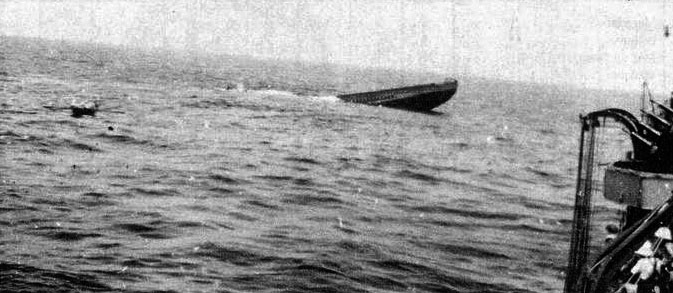
French Submarine Ajax, scuttled, sinking.
Conditions of the armistice initially planned all Redoutable class to be interned and disarmed but after the British attack on Mers-el-Kébir on 3 July the Germans allowed the French to keep their boats in full operational condition to defend French neutrality and territories. The Battle of Dakar (23-24 September) saw the subs present sent in action against the British armada. Persée was sunk by two British destroyers after fired and missed HMS Inglefield and Ajax later was fired upon, disabled and scuttled by her crew, in both case rescued by the British. On 25 September however Bévéziers (Captain Lancelot) managed to hit the battleship HMS Resolution, which ASW bulge protection system held, but she was sent in repairs for nine months. Good news for the axis no doubt.
On 28 October, the Vichy regime reorganized the French submarines forces under German and Italian armistice commission control. SubDiv 2 (Casabianca, Sfax, Bévéziers and Sidi-Ferruch) were relocated to Casablanca. SubDiv 3 (Vengeur, L’Espoir, Monge and Pégase) were sent to Madagascar. Bévéziers, Le Héros and Monge were present however during Operation Ironclad (the battle of Madagascar). The remainder were placed under guard at Toulon and were in alternated commission for regular trials runs and maintenance, but were not upgraded as this was forbidden, and only had limited fuel.
Poncelet was scuttled on 7 November 1940 during the battle of Libreville after torpedoing and missing the sloop HMS Milford, which shelled her back. Capt. Bertrand de Sausssine went down with the submarine. Some of the submarines remained in Dakar, Djibouti, and Indochina, and Sfax was accidentally sunk by U-37, as her supply ship Rhône while underway on 19 December to Dakar. In October 1941, four French cargo ships to Dakar were captured by the British and Le Glorieux, Le Héros were ordered to sail out for huring trade off South Africa as reprisal. But on 15 November Le Glorieux fired and missed a cargo off Port Elizabeth, while Le Héros sank the Thode Fagelund off East London.
On 31 July 1941, with the French Indochina invasion, Pégase was captured while back from a patrol. She was recommissioned by the Japanese but stationed in Saigon, disarmed on 1 January 1944, scuttled in March 1945, refloated in 1950 and eventually scrapped.
On 5 May 1942, the attack on Diego-Suarez saw Bévéziers sank by gunfire, as well as Le Héros by Fairey Swordfish. Monge managed to sally forth, tried torpedoed but missed HMS Indomitable, but she was spotted and sunk by destroyers.
The rest of the class was mostly lost at Toulon, after Operation Torch and the Germans launching Operation lila to attempt to captured the fleet at Toulon.
At Casablanca during the landings, Le Tonnant, Le Conquérant and Sidi-Ferruch were hammered by US aviation and badly damaged. On 9 November Le Tonnant made a sortie and tropedoes, but missed USS Ranger, which dodged these. The performances of Frenc torpedoes were again shown here: Too visible bubble trail, unsufficient speed and range. Le Tonnant tried to escape to Toulon, but but ended instead in Cádiz, scuttled. Conquérant and Sidi-Ferruch were sunk by aviation on 13 November. At Oran Actéon was sunk, depth charged by the destroyer HMS Westcott. Fresnel sortied, spotted, torpedoed but missed the cruiser HMS Jamaica, again, doging the torpedoes. She was hunted down for three days, but evaded and reached Toulon on 13 November.
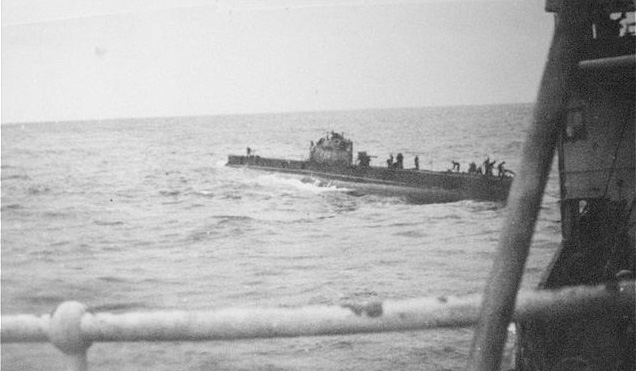
Submarine Glorieux resupplied by the MAC Quercy in 1942
On 9 November in Toulon were stationed Casabianca, Redoutable, Glorieux, Pascal and Henri Poincaré. They received authorization to be rearmed to sail to North Africa, but 11 November with Case Anton French sailors were confronted between Darlan’s order to scuttle their boats or join the allies in North Africa. The scuttling commenced on 27 November and concerned now Fresnel, Achéron, Vengeur, L’Espoir, hopeless in drydock, while Casabianca, Le Glorieux, Redoutable, Henri Poincare, and Pascal were afloat off Mourillon and could be readied to sail in a matter of hours. Only Glorieux and Casabianca with their fresh new new batteries and full fuel load were able to do so just as German troops entered Toulon, firing. The two subs navigated on their electric motors, accompanied by the 600-tonnes Vénus, Iris and Marsouin of the Requin class. Spotted, they came under fire by infantry and panzers. Redoutable, Henri Poincaré, Pascal and Fresnel were hit and unable toi continue, being scuttled by opening hatches. Achéron, Vengeur and L’Espoir in drydocks had the latter filled and sabotaged. These were all captured, later, intended for the Regia Marina, but repairs never went far and they never returned into service. Only Casabianca managed to reach Algiers (30 November), joining the Allies, and Glorieux at Oran.
Redoutable class with the Free French

By the end of 1942, only Archimède, Casabianca, Centaure, Glorieux, Protée were in allied-held Africa, the latter in Force X at Alexandria, reactivated to join the Free French by June 1942. They were all assigned to 8th British Submarine Squadron and by November 1943, 10th Squadron. Knowing their poor performances, the allies want them limited to information gathering and “spec ops transports”. Casabianca made seven of such missions in December 1942-September 1943 and took part in the liberation of Corsica.
Protée spotted and attacked but missed a cargo while on patrol, and between 18 and 25 December she hit a mine off Marseilles, lost with all hands. In the same area on 22 December 1943 Casabianca sank a submarine chaser and badly damaged the transport Ghisone. On 9 June 1944 she missed another sub-hunter off Cape Camaret but damagd her with gunfire. The Germans soon nickamed her the “ghost submarine” and she was the only one allowed to fly the Jolly Roger in 1943, following the RN squadron’s traditions.
In December 1942 and agreement for modernization of surviving Redoutable-class subs. The few concerned (including Casabianca) had their engines overhauled, new batteries changed, pressure hulls checked thorouhjly, repaired and reinforced, better diving systems, reworked ballasts with more bunkerage for better range, soundproofing measures and a new conning tower with radar, better underwater sound system and the latest asdic and US-standard instruments, air conditioning and efrigerator installed. The new conning tower not only received new telescopic masts but also two 20 mm Oerlikon AA guns. Archimède was the first to undego this, from 8 February 1943 to Philadelphia, staying for a year at Philadelphia Naval Shipyard, completed on 19 February 1944, followed by Le Glorieux, Le Centaure and Casabianca (2 August 1944-30 March 1945). Argo was denied this due to her poor general state. She became a training boat for US submariners.
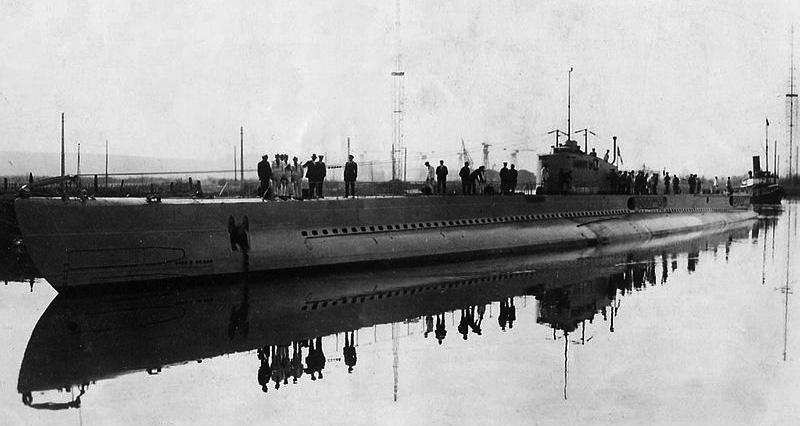
Prométhée, date unknown
Archimède carried out surveillance missions, intel gathering in March-August 1944 in the Med, but on 12 May she was attacked by three British aircraft, mistook for an U-boote. She escaped but on 13-14 July she was spotted by a German radar off Cape Dramont and chased by three patrol boats for hours, escaped again. On 16 July she attacked a small German convoy and fired on the aviso saved by its low draft. On 10 August they took part in Operation Dragoon. With the German traffic reduced targets became rare.
They spent the rest of the war in exercises at Oran, awaiting transfer to the Pacific, which never materialized. Casabianca received the Resistance Medal (as Glorieux), and Legion of Honour. Casabianca, due to her role with freeing Corsica, had her conning tower saved from the scrapyard and preserved in Bastia.
Postwar Fate
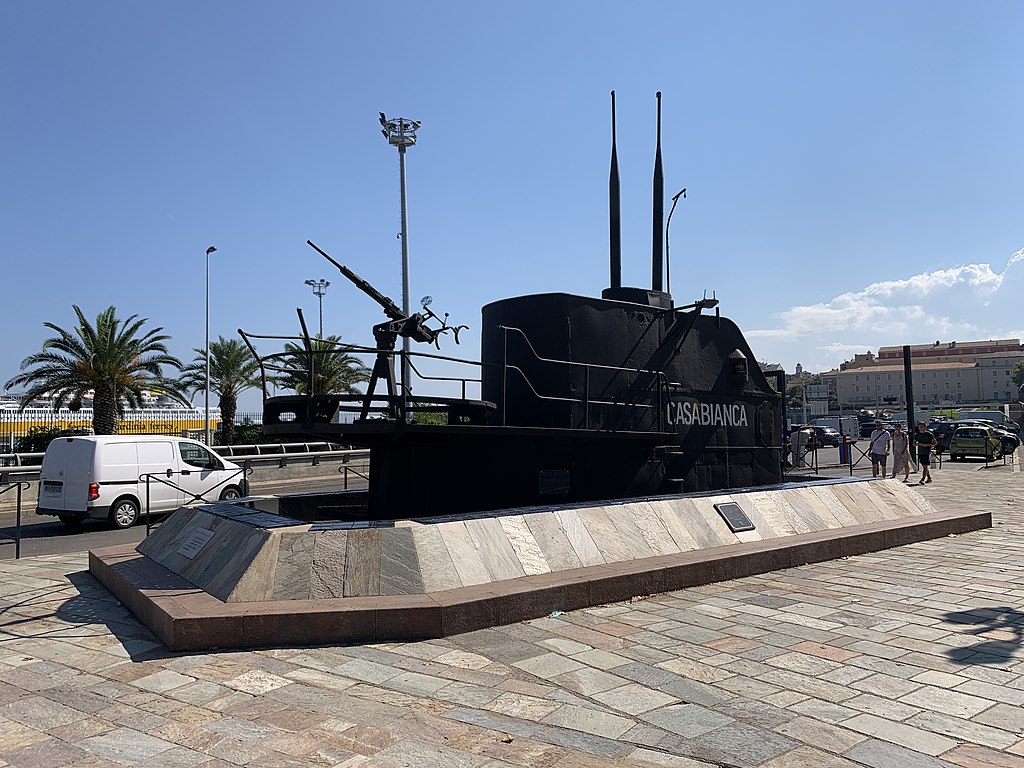
The preserved conning tower of Casabianca in Bastia, showing her state after reconstruction in the US.
Argo was disarmed in April 1946 and the remaining Free French subs became training vessels to train new crews and for underwater detection exercizes. Casabianca and Le Centaure made a long cruise in 1947. Refitting was and they ended in reserve, disarmed in 1952. Archimède and Le Glorieux were refitted in Cherbourg in 1946. They were based in Brest in 1947, sailing to africa with a war reparation Type XXI, Rioland Morillot, for tests. Archimède was placed in reserve by 31 August 1949, disarmed in 1952. Le Glorieux impersonated Casabianca for a 1949 movie and ended in reserve, disarmed in October 1952. They were replaced by ex-U-2518 (Roland Morillot) and British S-class submarines formerly in Free French service. Ultimately they were replaced by the new generation Narval class (1957). All had been scrapped by 1956.
 Redoutable (Ordered 1924)
Redoutable (Ordered 1924)

Redoutable in Toulon, 1928, shortly after completion
Launched 24 February 1928, completed 10 July 1931. Redoutable participated in early allied operations from 1939 to 1940, then with Vivhy France until scuttled on 27 November 1942 to prevent her capture by the Germans in Toulon. Refloated by the Italians in 1943 she was never repaired, sunk again on 11 March 1944 by an allied air raid, refloated after the war and BU.
 Vengeur (1924)
Vengeur (1924)
Vengeur was launched on 1 September 1928 and completed on 18 December 1931. In the interwar she was part of a group that were the first French submarines to cross the Atlantic Ocean. On 23 April 1937 she helped the testing of a tracking device making it easier to locate an airplane or airmen. She operated with the 7th Submarine Division based at Cherbourg and from June 1940 transferred to Bizerte, NAF. She patrolled against the Italians off Sicily, Salerno (Italy) and Sardinia. After the armistice she was in Toulon, travelled to Dakar, and then to Indochina via the cape, but was retained in Madagascar, went to Diego-Suarez, then back to Toulon where she was scuttled on 27 November 1942.
 Pascal (1925)
Pascal (1925)

Pascal was launched on 19 July 1928, completed on 10 September 1931. Soon after she tested a new acoustic system with hydrophones mounted in front of the forward diving planes, connected to a compensator acting as an underwater rangefinder, able to detect other submarines at 8,000 metres (8,750 yd) with a 2 degrees accuracy. In 1939-40 she served with the 4th Submarine Division, 1st Squadron in Brest. She patrolled the Atlantic Ocean south of the Azores, lloking for German U-boats and supply ships. After June 1940 she was at Bizerte with her 4th Division. She was scuttled at Toulon on 27 November 1942, refloated by the Italians, never repaired, and sunk in an air raid on 11 March 1944.
 Pasteur (1925)
Pasteur (1925)

Pasteur (Q139) was launched on 19 August 1928 and completed on 1 September 1932. On 12 May 1936, she collided with the DD L’Indomptable in Gironde estuary while in manoeuvers with the 2nd Light Squadron. In 1937 she made an endurance test to Cameroon. In 1939 she was with the 2nd Submarine Division. Later she escorted a Canadian allied convoy from Halifax. She was scuttled while under overhaul in Brest on 18 June and BU during the war to clear the basin.
 Henri Poincaré (1925)
Henri Poincaré (1925)

Henri Poincaré was launched on 10 April 1929 and completed on 23 December 1931. In 1939 she was in Brest with the 4th Submarine Division, 1st Squadron. She patrolled the atlantic from the Moroccan coast and Azores, then Bizerte. On off Missina she engaged but missled Italian Cruisers on 22 June 1940. From 1 August 1940, 5th SubDiv, then 5th SubDiv Casablanca 1942. Scuttled at Toulon on 27 November 1942, Refloated by the Italians as FR118, towed and later scrapped at La Spezia 9 September 1943.
 Poncelet (1925)
Poncelet (1925)
POncelet was launched on 10 April 1929 and completed on 1 September 1932. In 1939 she was in SubDiv 6, 4th SubRon, 1st Sqn in Brest. Atlantic Ocean, Azores, captured the German U-Boat supply cargo Chemnitz. In the Med on 18 June 1940 with the submarine tender Jules Verne. After Mers El Kébir patrolled French Morocco with Casabianca and Sfax. Transferred to SubDiv 6 in Dakar. October 1940 HP Port-Gentil, Gabon. Battle of Gabon: 7 November 1940, ordered to attack the Free French invasion force off Libreville. She was spotted on the surface, was attacked by HMS Devonshire‘s Walrus, had to crash dive, and was caught and DCs by sloop HMS Milford, forced to surface and scuttled after being heavily damaged.
 Archimède (1925)
Archimède (1925)
Archimède was launched on 6 September 1930 and completed on 22 December 1932. Operated with 4th SubDiv at Brest (North Sea, English Channel, Atlantic). 1938 SubDiv 6 Bizerte NAF. Refit Casablanca, Brest 1939. Collided Feb.1940 with trawler. April escorted Convoy HX-39 from Halifax. June escorted Convoy BT-47 to Casablanca. Toulon, Dakar, Casablanca in 1941. Deployment to Indochina cancelled after Op. Torch NoV. 1942. Swapped Free French, departed Dakar February 1943, refit Philadelphia USA to Feb. 1944, Med Operations. Operation Dragoon Aug. 1944 as spec ops boat. Refit Cherbourg 1946. Stricken and BU February 1952.
 Fresnel (1925)
Fresnel (1925)
Fresnel was launched on 8 June 1929, completed 22 February 1932. 1933-34 made gravimetric measurements northwestern Mediterranean Basin. 1937 made with Achéron, Agosta, and Bévéziers a cruise to Argentina. 1939 SubDiv 3, SubRon 3, 1st Flot. 2nd Squadron in Toulon. Patrolled Canary Islands. Boarded SS Nyassa, took German POW. HP Bizerte May-June 1940. Subdiv 5 Casablanca 1941. 8 Nov 42 attacked RN ships off Arzew. Shelled, depht charged, torpedo missed HMS Jamaica. Back Toulon, scuttled 27 November. Refloated by the Italians 28 January 1943. Sunk air raid 11 March 1944.
 Monge (1925)
Monge (1925)
Monge was launched on 25 June 1929, comp. 19 June 1932. 1936-37 deployed Indochina. 1938-39 SubDiv 5, SubRon 3, 1st Flotilla 2nd Sqn Toulon. June 1940 patrolled for Italian convoys Italy-Tripolitania. Bizerte Oct. 1940 planned for Indochina. Dakar, Madagascar, held there due to new situation. Battle of Madagascar: Tried to attack HMS Indomitable. Sunk by HMS Active and HMS Panther off Diego Suarez 8 May 1942.
 Achille (1926)
Achille (1926)
Achille was launched on 28 May 1930 and completed on 29 June 1933. Cruised 1937 to Cameroon. Based in Gabon by 1938. SubDiv 2, SubRon 4 (1st Flotilla) in Brest 1939. Scuttled there on 18 June 1940 as she was in overhaul and could not escape.
 Ajax (1926)
Ajax (1926)

Ajax was launched on 28 May 1930 and completed on 1 February 1934. 1939 Brest, SubDiv 6. Escorted convoy HX 41 from Halifax. Sep. 1940 in Dakar. Battle of Dakar 24 September 1940: Tried to attack HMS Barham and HMS Resolution. Sonar detected. Damaged by the destroyer HMS Fortune, scuttled after the evacuation of the crew.
 Actéon (1926)
Actéon (1926)
Actéon was launched on 10 April 1929, completed by 18 December 1931. 1939 Toulon, SubDiv 3. Search Atlantic for the Altmark. Transferred Canasblanca, Patrolled canary Is. Bizerte, Beirut May-June 1940. Inactivated in Toulon. July 1941 transferred Dakar. Jan 1942 reassigned Casabanca. Operation Torch: Tried to sink HMS Biter and HMS Dasher off Cape Falcon. Sunk off Oran by the destroyer HMS Westcott on 8 November 1942 at 21:11.
 Achéron (1926)
Achéron (1926)
Achéron was launched on 6 August 1929 and completed on 32 February 1932. 1939 SubDiv 3, SubRon 2 in Toulon. Patrolled to French West Indies and from Casablanca. Feb. 1940 patrolled Canary Islands. Bizerte, Beirut, Alexandria. June Patrolled Aegean Sea and Libya. 16 June 1940 missed an Italian TB. October 1940 back in Toulon. Scuttled 27 November 1942. Refloated July by the Italians, sunk in an air raid, 24 November 1943.
 Argo (1926)
Argo (1926)

Argo off the US east Coast, 16 Nov. 1944.
Argo was launched on 11 April 1929, completed on 12 February 1933. Subdiv 4 in Brest 1939. Patrolled Azores and Canary Islands. Casabanca Feb. 1940, then Bizerte. March 1942 Casablanca. Ran aground 5 July 1942, repaired. Aug. 1942 Dakar Subdiv 3. After Op. Torch, Free French, but not selected for refit in the US. Sierra Leone, as training target for British ships. 1943-44 patrolled from HP Bermuda, New London, Key West. Collided with USS Huron (PF-19, Tacoma class). Repaired, served with the U.S. Navy sound school. Disarmed april 1946 and BU.
 Prométhée (1927)
Prométhée (1927)

Promethée was the Redoutable class with the shortest carrer, and most tragic, as on after launching on 23 October 1930 she was never commissioned. Soon after completion she sunk accidentally on 7 July 1932 during trials. Reasons are still unclear today. The official investigation concluded an “unexpected, rapid and general opening of the purges” was the culprit. She reached crushed-depht.
 Persée (1927)
Persée (1927)
Persée was launched on 23 May 1931 and completed on 10 June 1934. During her trials the crankcases of her Schneider diesel motors leaked oil and exploded, killing 2 and injuring others, including the XO Jean L’Herminier (future captain of Casabianca). 1939 she was in brest, SubDiv 6. Patrolled the Azores. In Casablanca by June 1940. In Dakar by August. Sunk during the Battle of Dakar 23 September 1940: Torpedo-missed by HMS Inglefield on the surface off Cap Manuel, hunt by British destroyers, unable to dive due to shoals and destroyed.
 Protée (1927)
Protée (1927)
Protée was launched on 31 July 1930 and completed on 1 November 1932. In 1939 SubDiv 3 in Toulon. Feb. 1940 HP Casablanca, patrolled Canary Is. April 1940 Bizerte, Beirut, Alexandria. Patrolled Dodecanese June 1940. Captain disobeyed orders to Beirut, sailed to Alxandria, joined Force X and the allies. June 1943 in Oran. 22Nov. attacked but missed German cargo ship. Patrolled off Marseilles but hit a mine on 20 December 1943 off Cassis and sank.
 Pégase (1927)
Pégase (1927)
Pégase was launched on 28 June 1930 and completed on 19 June 1932. She was the only one in her classes stationed in Indochina in WW2. She served there in 1936-37 but was back in Toulon in 1938, and SubDiv 5 by 1939. In June 1940 she preyed on convoys between Italy and Tripolitania. Assigned by Vichy to Indochina and crossed Gibraltar straot with destroyers Casque and Épée, reached Casablanca and Dakar, proceeded to Madagascar. Unlike the orthers she proceeded to Saigon with Monge and the supply ship Lot on 6 March 1941, missing the Franco-Thai war. Cruised local waters and China sea. Monge departed for Madagascar but she remained. Allowed by the Japanese after occupation of Saigon on 31 July 1941 to protect french trade. Planned to sail to Dakar but cancelled after Torch Nov. 1942. January 1943 crew interned. Decommissioned 1 January 1944 in Saigon, scuttled 9 March 1945.
 Phénix (1927)
Phénix (1927)
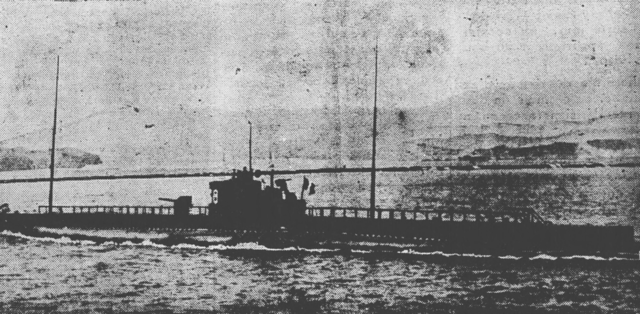
Phénix was the other accidental loss of the class. She was launched on 12 April 1930 and commissioned on 21 October 1932. Due to tensions in 1938 she was sent to Indochina. She sank to csush depth accidentally on 15 June 1939 off Cam Ranh northeast of Saigon while training with Lamotte-Picquet. She just failed to surface after the exercise. Investigation pointed an explosion when her batteries released hydrogen gas due to poor material condition (her overhaul was long overdue since 1932).
 L’Espoir (1929)
L’Espoir (1929)
L’Espoir (“hope”) -Q167- was launched on 18 July 1931, commissioned on 1 February 1934. While in Toulon she suffered two accidental explosions on 13 July 1935 and a battery fire on 27 July 1938 (1 dead). Sent to Indochina November 1938 Via Port Said, Djibouti, Colombo. Cruised local waters, visited hong kong and Manila. Trained with Lamotte-Picquet when Phénix was lost. 1939 Toulon SubDiv 5. Planned to returned to Indochina, stopped at Dakar, Madagascar, but damaged, drydocked at Diego-Suarez, returned Dakar. Back to Toulon via Casablanca. Scuttled on 27 November 1942, never raised, BU postwar.
 Le Glorieux (1929)
Le Glorieux (1929)
Le Glorieux was launched on 29 November 1932 and comm. on 1 June 1934. In 1937 she received a hoisting periscopic antenna. Subdiv 1 Toulon 1939. February 1940 HP Dakar. Trained with the RN off Freetown March 1940. July 1940 spotted HMS Dorsetshire off Dakar, spotted by a Latécoère 302. Torpedo attack failed, attacked in return by her seaplane. Interned Casablanca August. Co-claimed Cap Olmo off the Cape Nov. 1940. Escorted convoys Madagascar-Djibouti (French Somaliland) blockaded. Operation Ironclad 6 May 1942 attacked by British destroyer. Back to Toulon. Nov. 1942 escaped to NAF. Joined FNFL. Sent USN sound school Bermuda, modernized Philadelphia. Back Med May 1944. Took part Operation Dragoon August. Oran 1945, TS. Disarmed 1946, discarded and BU October 1952.
 Le Centaure (1929)
Le Centaure (1929)
“Centaurus” was launched on 14 October 1932 and commissioned on 1 January 1935. Subdiv 4 in Brest 1939, then HP Casablanca, patrolled Azores-Canary Is. June 1940 patrolled Sardinia, messina strait, Augusta, Sicily against Regia Marina. HP Bizerte, Toulon, disarmed july. Aug. 1942 transferred Dakar. Nov.42 joined FNFL. Served with RN sound school at Freetown. Modernized US until Dec. 1944. Little service to 1945 between Oran and Bermuda. Reserve Dec. 1947. Discarded and BU 19 June 1952.
 Le Héros (1929)
Le Héros (1929)
Le Héro was launched on 14 October 1932 and completed on 12 September 1934. In 1939 Subdiv 1 Toulon. Searched for Altmark. Patrolled South Atlantic. April 1940 Bizerte, then Dakar. Tried to attack HMS Dorsetshire. Back Toulon, then sent to Madagascar. She was sunk on 7 May 1942 during the Battle of Madagascar, depht charged off Courrier Bay by Fairey Swordfishes from HMS Illustrious.
 Le Conquérant (1929)
Le Conquérant (1929)
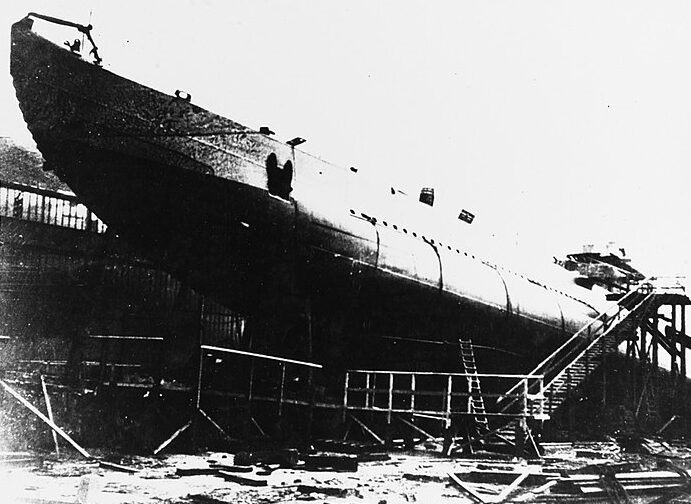
Le Conquérant was launched on 26 June 1934 and commissioned on 7 September 1936. She served in Indochina by 1938. In 1939 she was in Toulon with SubDiv 1. In July 1940 Le Conquérant sailors, who had attempted to reach Free French forces via Spanish Morocco were arrested and jailed in Casablanca. January 1942 SubDiv 4, Dakar. Nov. Drrydocked Casablanca. sunk on 13 November 1942 off Río de Oro during the Naval Battle of Casablanca.
 Le Tonnant (1929)
Le Tonnant (1929)
Le Tonnant was launched on 15 December 1934 and completed on 1 June 1937 after much delays. During her shakedown, some sailores tried to capture her to send her to the Republicans during the civil war (later arrested and jailed). Made her TOD in Indochina 1938. SubDiv 1 Toulon 1939. Dakar Feb. 1940. Bizerte May-June 1940, patrolled against Italian convoys. Back to Toulon July. Battle of Casablanca: Damaged by SBD Dauntless and TBF Avenger from Suwanee and Ranger 8 Nov. 1942. Managed to escape. Scuttled off Cadiz, Spain, 15 November.
 Agosta (1930)
Agosta (1930)
Agosta was launched on 30 April 1934 and commissioned on 1 February 1937. She received air conditioning and make her shakedown to Argentina. Subdiv 8 in Brest 1939. Scuttled at Brest on 18 June 1940 while under overhaul to avoid capture.
 Bévéziers (1930)
Bévéziers (1930)
Bézevier was launched on 14 October 1935 and commissioned on 4 June 1937. In 1939 Subdiv 8 in Brest. Patrolled northern Spanish coastline, escorted HX 29 and HX 33 from Halifax. Patrolled Gulf of Guinea from Dakar summer 1940. Battle of Dakar, she managed to torpedo and hit HMS Resolution on 25 September. October 1940 sent to SubDiv 2 (Casabianca, Sfax Sidi-Ferruch) in Casablanca. Refitted Toulon, sent Madagascar 19 February 1942. Sunk on 5 May 1942 during the Battle of Madagascar: Taken by surprise during the preliminary bombardments, sailed out under Swordfish attacks and sunk by depht charges.
 Ouessant (1930)
Ouessant (1930)
Ouessant (Q180) was launched on 30 November 1936, commissioned on 1 January 1939, soon before the war. In 1938 she was torpicalized and had her ballast tanks galvanized for her shakedown cruise in Dakar. Subdiv 8 in Brest 1939. Patrolled off Vigo, French Antilles and between Trinidad and Venezuela. Started Overhaul Fabruary but scuttled at Brest on 18 June 1940 to avoid capture.
 Sidi Ferruch (1930)
Sidi Ferruch (1930)
Sidi Ferruch was launched on 9 July 1937 and commissiooned on 1 January 1939. Subdiv 8 Brest, patrolled as Ouessant. Escorted Convoy HX-27 from Halifax. Casablanca in May 1940. Sent July 1940 to Dakar. Sent Cameroon and French Equatorial Africa. Battle of Dakar, attacked by Ark Royal’s planes. October 1942 SubDiv 2 Casablanca. Sunk 11 November 1942 off French Morocco during the Naval Battle of Casablanca by US air raid.
 Sfax (1930)
Sfax (1930)
Sfax was launched on 6 December 1934, commissioned on 7 September 1936. She was the only of three subs of her class to receive a radio direction finder. Subdiv 2 in Brest 1939 with Achille, Casabianca, and Pasteur, atlantic patrols. Escorted Convoy HX 11 from Halifax. Took part in the Norwegian campaign. Mistook as U-Boat by Achille, nearly missed. The irony was she was torpedoed by the German U-boat U-37 on 19 December 1940 while bound for Dakar, mistook for an allied boat…
 Casabianca (1930)
Casabianca (1930)
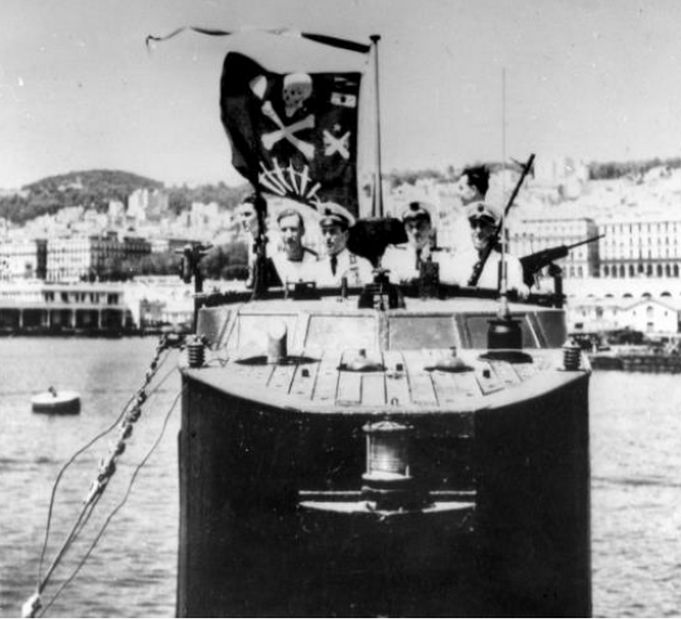
Casabianca’s displaying the Jolly Rogers, following the RN tradition after her kill. src
The most famous and decorated submersible of her class was launched on 2 February 1935 and commissioned on 1 January 1937. Her whole career would be too long to describe here. She was the “corsican sub” named after a naval officer from Corsica of the French Revolutionary Wars. Part of her crew was also from Corsica. 1939 Sub Div 2 in Brest. By December 1939 she escorted Convoy HX 11. She was in Toulon during the German operation Case Anton to capture the fleet and one of the few which managed to escape. She joined allied-controlled NAF and joined the FNFL. She was modernized in the US and took part in the liberation of Corsica, soon nicknamed “Ghost Submarine” by the German as she mainly directed spec ops and intel operations. She took part also in Anvil Dragoon. She was dismantled on 12 February 1952 but her conning tower has been preserved and is now in Bastia, Corsica.

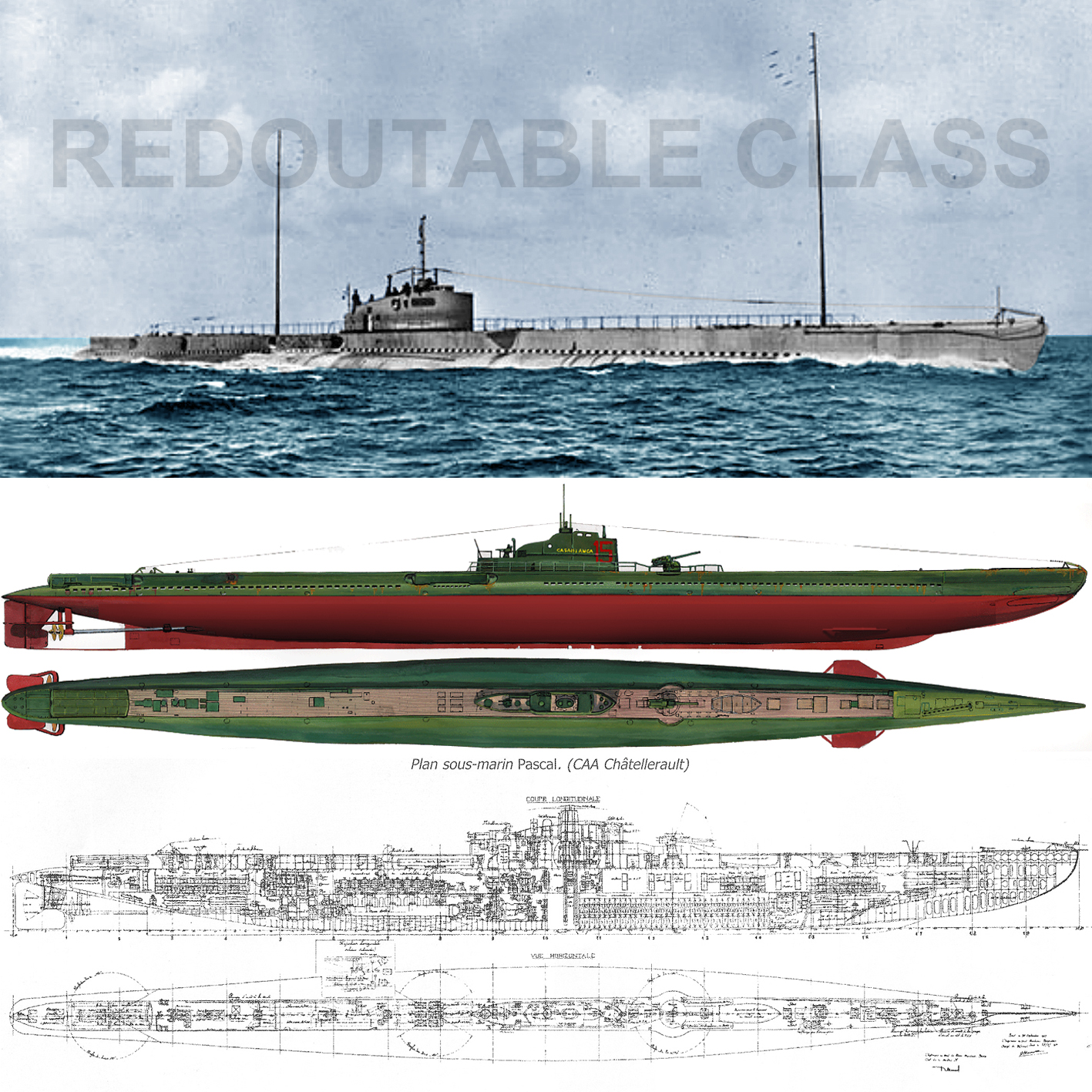
 Latest Facebook Entry -
Latest Facebook Entry -  X(Tweeter) Naval Encyclopedia's deck archive
X(Tweeter) Naval Encyclopedia's deck archive Instagram (@navalencyc)
Instagram (@navalencyc)





 French Navy
French Navy Royal Navy
Royal Navy Russian Navy
Russian Navy Armada Espanola
Armada Espanola Austrian Navy
Austrian Navy K.u.K. Kriegsmarine
K.u.K. Kriegsmarine Dansk Marine
Dansk Marine Nautiko Hellenon
Nautiko Hellenon Koninklije Marine 1870
Koninklije Marine 1870 Marinha do Brasil
Marinha do Brasil Osmanlı Donanması
Osmanlı Donanması Marina Do Peru
Marina Do Peru Marinha do Portugal
Marinha do Portugal Regia Marina 1870
Regia Marina 1870 Nihhon Kaigun 1870
Nihhon Kaigun 1870 Preußische Marine 1870
Preußische Marine 1870 Russkiy Flot 1870
Russkiy Flot 1870 Svenska marinen
Svenska marinen Søværnet
Søværnet Union Navy
Union Navy Confederate Navy
Confederate Navy Armada de Argentina
Armada de Argentina Imperial Chinese Navy
Imperial Chinese Navy Marinha do Portugal
Marinha do Portugal Mexico
Mexico Kaiserliche Marine
Kaiserliche Marine 1898 US Navy
1898 US Navy Sovietskiy Flot
Sovietskiy Flot Royal Canadian Navy
Royal Canadian Navy Royal Australian Navy
Royal Australian Navy RNZN Fleet
RNZN Fleet Chinese Navy 1937
Chinese Navy 1937 Kriegsmarine
Kriegsmarine Chilean Navy
Chilean Navy Danish Navy
Danish Navy Finnish Navy
Finnish Navy Hellenic Navy
Hellenic Navy Polish Navy
Polish Navy Romanian Navy
Romanian Navy Turkish Navy
Turkish Navy Royal Yugoslav Navy
Royal Yugoslav Navy Royal Thai Navy
Royal Thai Navy Minor Navies
Minor Navies Albania
Albania Austria
Austria Belgium
Belgium Columbia
Columbia Costa Rica
Costa Rica Cuba
Cuba Czechoslovakia
Czechoslovakia Dominican Republic
Dominican Republic Haiti
Haiti Hungary
Hungary Honduras
Honduras Estonia
Estonia Iceland
Iceland Eire
Eire Equador
Equador Iran
Iran Iraq
Iraq Latvia
Latvia Liberia
Liberia Lithuania
Lithuania Mandchukuo
Mandchukuo Morocco
Morocco Nicaragua
Nicaragua Persia
Persia San Salvador
San Salvador Sarawak
Sarawak Uruguay
Uruguay Venezuela
Venezuela Zanzibar
Zanzibar Warsaw Pact Navies
Warsaw Pact Navies Bulgaria
Bulgaria Hungary
Hungary

 Bundesmarine
Bundesmarine Dutch Navy
Dutch Navy Hellenic Navy
Hellenic Navy Marina Militare
Marina Militare Yugoslav Navy
Yugoslav Navy Chinese Navy
Chinese Navy Indian Navy
Indian Navy Indonesian Navy
Indonesian Navy JMSDF
JMSDF North Korean Navy
North Korean Navy Pakistani Navy
Pakistani Navy Philippines Navy
Philippines Navy ROKN
ROKN Rep. of Singapore Navy
Rep. of Singapore Navy Taiwanese Navy
Taiwanese Navy IDF Navy
IDF Navy Saudi Navy
Saudi Navy Royal New Zealand Navy
Royal New Zealand Navy Egyptian Navy
Egyptian Navy South African Navy
South African Navy






























 Ukrainian Navy
Ukrainian Navy dbodesign
dbodesign